Three Corten rectilinear solids.
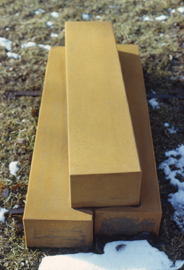 |
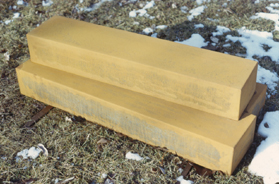
|
Welded aluminum platforms.
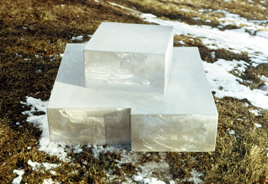
"One Over Two." |

"One Over Four." |

"One Over Five." |
The Modular Set evolved from a series of porcelain enamelled sculptures begun in London in 1967, using groups
of similar panels which assembled to describe the surface of low rectilinear platforms. Later while I was
working in New York these became the basis for larger and more complex geometric entities, which were inspired by the
experience of Manhattan's colossal architecture to identify more and more with landscape.
When I began working
in Iowa City, the panels developed mass, and the sculptures became grouped and layered arrangements of rectilinear
solids, initially welded in steel and aluminum, as illustrated below, in these sculptures from 1971.
Three Corten rectilinear solids.
 |

|
Welded aluminum platforms.

"One Over Two." |

"One Over Four." |

"One Over Five." |
However the design and fabrication process inevitably led me to the proposition that systematically managed proportioal relationships amongst all the elements used as a set might characterize unique groupings in ways that would encourage their exploration for structural metaphor, by casting the viewer's attention beyond the arrangements themselves in the search for meaning.

"15 over 16, Mesa" at the University of Iowa Museum of Art, 1971.
"Mesa" was my first iteration of the Modular Set. While teaching at the University of Iowa I had planned to build a set of regular geometric solids based on the cube, which could be re-arranged into a variety of composite monolithic forms, much as certain desert landscapes of the western United States displayed their geologic nature. I chose a scale for the elements convenient to handle, close to the human scale, and large enough in size and number to draw in their local environment. The set was to include eighty 6" square forms, sixteen of each were to be 6", 12", 2', 4', and 8' long repectively. Construction continued through 1973, with the set of 8' elements finished during the Fall quarter that year at the University of Kentucky.
Mesa was built from an arrangement of sixteen 4' long masonite boxes, with fifteen 2' long boxes laid on top in a centered rectangular array. A mould was made of the arrangement which was then cast in plaster of paris in one piece, and exhibited without further finishing.
The Iowa City Studio, 1972-3.
Shortly after Mesa was completed, I found a larger studio space off campus, and was able to broaden my exploration of the display possibilities of the set. Arrangements suggesting architectural structures, exploring effects of light and open space, and more ephemeral "natural" patterned and arbitrary groupings, became new subjects.
Progression.
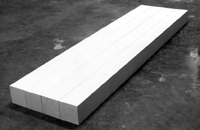
"1x4x16." |
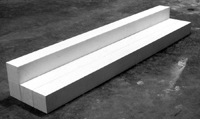
"2x3x16." |
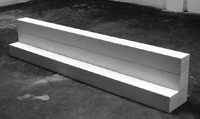
"3x2x16." |

"4x1x16." |
Linear continuae.
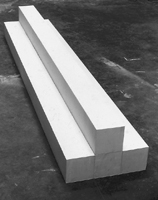
"1 over 3x16" |
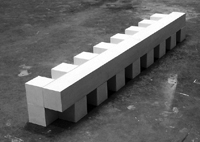
"2x16;16x1" |
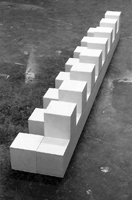
"1x16;16x1" |
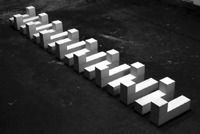
"1 over 1x4, x16 alternating
|
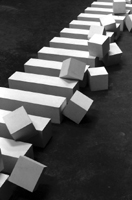
"1x4x16 spaced 1 apart |
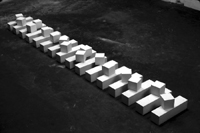
"1x4x16 spaced 1 apart |
Structural progressions / illuminated.
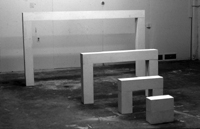
"2x2;3x4;5x8;9x16." |

"1 under 2;4;8;16." |
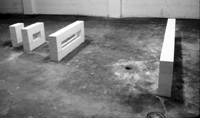
"3x2;4;8;16." |
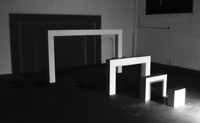
"2x2;3x4;5x8;9x16." |

"1 under 2;4;8;16." |

"3x2;4;8;16." |
Rotating arrangements.
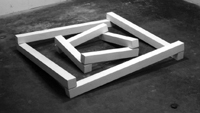
"4x16 around 4x8." |
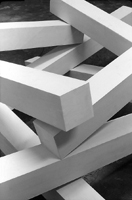
"4x8 on 4x16; detail" |
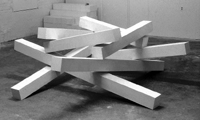
"4x8 on 4x16." |
Layered arrangements.
The layered arrangements in particular invited comparison to wave patterns in nature. Rythmic events such as ripples, and geologic and cloud formations, reinforced by my experience of seeing these from the vantage point allowed while travelling by plane. These arrangements represented fragments of organizational continuae, their display limited only by the total number of available pieces in the set. In the cloud series and later, the geometry availabe at each level was contained by its ability to find support from the layer below. In all of these groupings each element of the set was linked through direct contact with the whole.
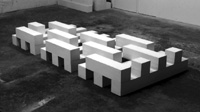
"1x4s in staggered rows over 9 1x8s." |
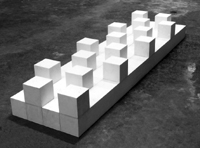
"16 1x1s in staggered rows over 4 1x16s." |
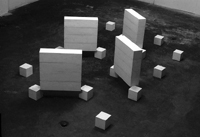
"Towers." |
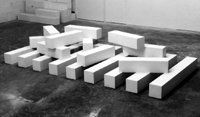
"10 random 1x4s over 9 aligned 1x8s." |
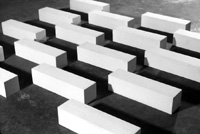
" 16 1x4s." |

"12 1x8s over 16 1x4s." |
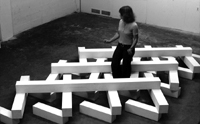
"3 1x16s over 12 1x8s over 16 1x4s." |
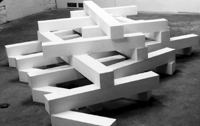
"5 centered layers: Cloud." |

"5 layers, Cloud II." |
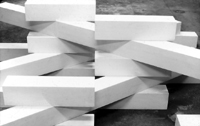
"5 layers, Cloud II detail." |
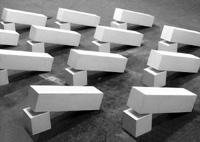
"Swell/Cloud III: First two layers." |

"Swell/Cloud III: First three layers." |
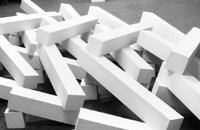
"Swell/Cloud III: Layers 1-4." |
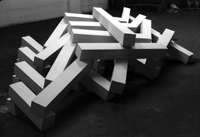
"Swell/Cloud III: Five layers." |

"Swell/Cloud IV: Four layers." |

"Swell/Cloud IV: Detail." |
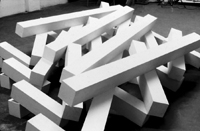
"Swell/Cloud IV: Detail." |
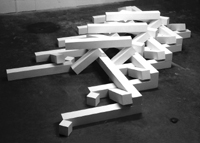
"Swell/Cloud V." |
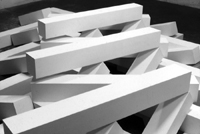
"Swell/Cloud V: Detail." |

"Swell/Cloud V: Detail." |

"Swell/Cloud V: Detail." |
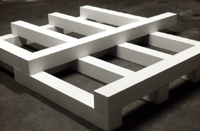
"Untitled Wave/base form." |

"Untitled Wave/base form." |
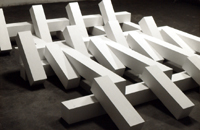
"Untitled Wave." |
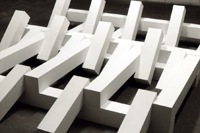
"Untitled Wave." |
Framed arrangements.
The framed arrangements were attempts to present models of an architectural type of space using post and lintel structures together with the regular repetitive distribution of modules to suggest socially interactive volume.
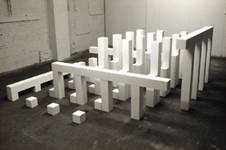
"Parallel lintels." |

"Rear left view." |

"Front right detail." |
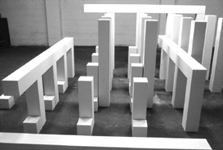
"Front detail." |

"Front left detail." |
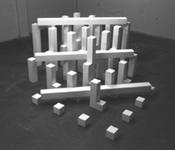
"Diagonal Lintels." |
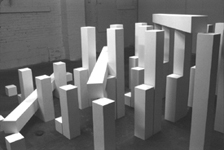
"Right side detail." |
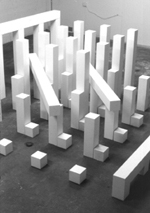
"Parallel/Diagonal front left view." |
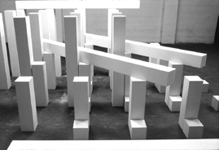
"Front view detail." |